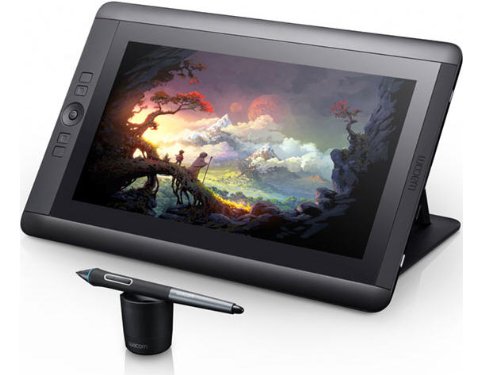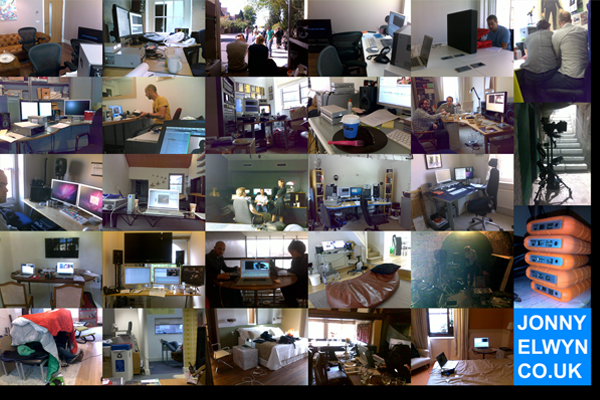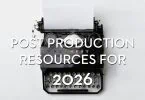Inside A Professional Edit Suite
Editing on @Avid @mediacomposer RT @RealRonHoward: editing room today on In the Heart of the Sea pic.twitter.com/E5c3V3KguG #Avid #postchat
— Wim Van den Broeck (@editorbelga) May 7, 2014
If you’ve ever wondered what a professional edit suite looks like then this round up of photos, videos and edit suite design tips should give you a great insiders look! And if you want to be able to look even closer, check out this popular round up of editor’s timelines.
Here, the first few photos come from Ron Howard’s edit suite on his current film In The Heart of The Sea.
Day 2 in editing room on In the Heart of the Sea. Another fascinating post prod challenge akin to Rush or Apollo 13 pic.twitter.com/f4yXRsQdk2 — Ron Howard (@RealRonHoward) January 7, 2014
Back to Heart of the Sea edit room designing storm sequence pic.twitter.com/wZgYiVtlrX
— Ron Howard (@RealRonHoward) January 15, 2014
Not all edit suites as are as comfortable looking as Ron Howard’s – here’s Darren Aronofsky cutting Noah, standing up in his (seemingly) make-shift suite.
24-7-365 cutting pic.twitter.com/GmaWdNw349 — darren aronofsky (@DarrenAronofsky) December 7, 2013
In these last two images you can check out documentary editor’s Shane Ross and Steve Audette’s edit suite set ups. Check out the next section of this post for Shane’s write up of his suite.
Here’s the pic. Now to see how this performs I was going to close lid and go with 2, but @dwolfmeyer suggested this pic.twitter.com/tLI3fqUjeR
— Shane Ross (@comebackshane) May 3, 2014
Not so typical day for me. Thank you internet failure time to ponder @AdobeStory scripts. #documentary #MediaComposer pic.twitter.com/cPJO0eQzJo — Steve Audette (@stevecutsdocs) April 30, 2014
PBS Frontline documentary editor Steve Audette, kindly took the time to email a detailed breakdown of the gear in his suite. Speaking of Steve, if you’ve not seen his excellent lecture on documentary editing, then you’ve been seriously missing out.
Behind my head on the wall are important documents for durations and deadlines. Also you can see the “ten commandments of typography”and a motivational graphic of the 7 minute workout. Maybe I need to spend more time with that one.

Above the laptop is a plasma client monitor – I have two in my room this one is for me, the other is down way out of picture. Then my bin monitor and my composer monitor these are old NEC 24 inch that need replacing as they have ghost images. Below the bin monitor is the router (which I hardly use now with file based media) a telephone, a track ball and keyboard.

Tucked under my client monitor is an 01v mixing board. Again, I hardly use that now as I do all initial mixing in the Avid Media Composer for both rough cuts and fine cuts. Final mixing goes to the protools system upstairs. Back in the day I would work with 8 direct outs of audio and compress the narration channel and main interview channel on the O1v, now I do tha
Finally up in the upper right of the photo, there is the Plumb Bob. Homage to telling the straight line of a story and not wavering to the pull of some sequence off the narrative. Keep the line, like the Plumb Bob straight and true.
If you have any questions ask me on Twitter or Facebook. Now back to my nap…
Anatomy of an Edit Suite
In this excellent three part video series, editor Walt Biscardi builds on one of his most popular blog posts ‘Anatomy of an edit suite‘ by updating things and going into a bit more detail on all the core components of a professional edit suite, including the chair, desk, mice and tablets, monitors, standing desks etc. Walt has also written up an post on designing a suite around an iMac, which is worth a look too.
Editor Shane Ross has also helpfully written up a detailed description of how he transformed his suite from one based around at 2008 Mac Pro to one based around a 2012 non-retina Macbook Pro – making the most of all those Thunderbolt peripherals to expand his edit suite.
The MacPro has a Kona 3 card, and I happen to have an AJA IoXT (and BMD Ultrastudio Mini Monitor) that connect to the laptop via Thunderbolt. So that part is covered. The IoXT has Thunderbolt loop through, so I am able to then connect a Thunderbolt to DVI adapter and have a second monitor. That leaves me with a Firewire 800 port and a USB 3 port for connecting hard drives (I use one USB port for a keyboard and mouse).
If you’re after more details on the best Thunderbolt devices for film editors check out these two extensive previous posts:
Thunderbolt Peripherals for Film Editors
Thunderbolt 2 RAIDS for Film Editors
In this last video, which I previously posted in this Avid Media Composer 7 post, you can check out all the gear that editor Leo Mahoney uses in his suite. It’s a really interesting mix of analogue and digital gear connected together.
Over the past 10 years or so I’ve edited in a multitude of places including, pubs, airplanes, the back of a truck, church crypts, bedrooms, hotel rooms and many other places besides around the world. Hit the photo above to jump through for a closer view!
Tips for Designing a Professional Edit Suite

The current trend in small suite design is to build a room that’s very client-friendly and not intimidating. Usually this involves a workstation with one or two displays, near field audio monitors, a small mixer (mainly for volume control) and one or two video monitors. I like to work with dual displays (like two Apple 20” LCDs), but a single, larger monitor, like a 27” or 30” is also quite functional.
Editor Noam Kroll has also written up a lengthy description of his edit suite re-build after moving from Toronto to Los Angeles, and offers some really useful tips.
Let’s start at the back of the room where one of the most important elements to the room is installed – the Curtains. Yes the curtains.
Simple, but they are extremely important. If there are only two things you ABSOLUTELY need in an editing room (besides a computer) they are: a door on the room and light control. The light control is paramount to ensure that if you do any color/vfx work, you have an optimal viewing condition for making color critical decisions.
Even if you aren’t a colorist or VFX artist, the light control is a must as glares on your screen can affect your ability to work properly. So make sure to get some blackout blinds or curtains that will kill any light spilling through the windows.









Hi Mr. Elwyn,
I am setting up an editing suite. I am interested in the technical spec of the ideal editing suite. the configuration of all the little detail that you can provide. highly appreciated.
Hi Girish
I’m afraid that’s kind of an impossible question to answer! There are lots of things to consider and it all depends on what you want the suite to do. For example I like to have a light, bright space with a view, but that would be terrible for colour grading! (Dark windowless room, 18% grey walls etc.) Also if you’re going to do a lot of sound mixing etc then you’ll want some decent speakers, maybe a small mixing desk (though you could probably get an ipad app to replace it). Also I like to stand and sit, so I’d pony up for a standing desk – but that causes problems for all of your gear, which needs to be able to adjust with the desk. Plus you’ll want a really comfortable chair for all those hours of sitting. I always edit with a Wacom tablet so I’d get one of those. If you’re charging for grading then you’ll want an expensive grading monitor, if not, then a nice computer monitor will suffice.
It all depends on what you’re trying to achieve! (And how much money you’ve got to spend….)
Thank you,
I always love the insider’s view 🙂
These are some very nice workspaces. I’m gonna try some of this. First thing on the list: Raising my monitors!
Yeah essential for good ergonomics!